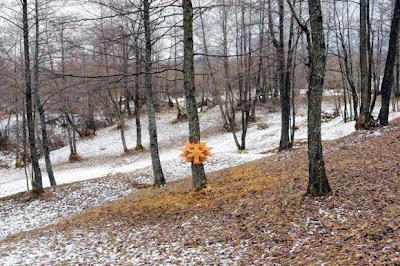

Mircea Cantor, (TOP:) The Need for Uncertainty, 2008; (BOTTOM:) Airplanes and Angels, 2008. Both copyright Mircea Cantor, courtesy Yvon Lambert, Paris, New York.
Mircea Cantor, Camden Arts Centre, 20 Feb-19 April 2009.
Mircea Cantor has worked with film installations before but his new show at the Camden Arts Centre has no film but two live peacocks. It's a curious, thought-provoking substitution and this review is partly a working through of that act, to see if it's one more film makers could usefully follow.
Two peacocks sit inside a domed gold cage. Actually, it's a Russian doll nesting of three cages of decreasing size inside one another. The largest disappears into the wall before completing its circumference, the smaller two fit complete inside, each with their own cage door left invitingly open. Some conifer branches are placed on the wood chip covered floor, and the smell of the whole thing is very zoo.
It was whilst considering this vaguely Esche-evoking peacock house that I first realised some of the short comings of live peacock-based installations. I went on a Sunday so maybe the peacocks were having some down time, but they largely hid behind the conifer branches. Eventually, one came out for a bit of a strut, but there was no tail fanning or extravagant courtship of any kind, which was a shame. Contemporary art gets you accustomed to a expect a spectacle, not the psychological problems of the ornate but performance shy.
The peacocks also seemed unaware of the labyrinthine Borges-like possibilities of their environment, preferring just to wonder around a small area of woodchip, in a manner that, if they keep it up, will get the RSPCA interested. Had they not been listening to their keeper when he read aloud those chapters from Relational Aesthetics?
But what kind of space results from a peacock in a gallery? Once you've seen the pictures, Joseph Beuys Coyote: I Like America and America Likes Me (1974) becomes the ur- reference point for these kinds of gallery based animal-encounters. The relationship to - or between - wild otherness within the gallery. Whether the Beuys piece was like that outside the photos is another question altogether. From the description (I haven't seen it), Cantor's own Departure (2005), where a deer and a wolf meet in a white cube, would also seem to be occupying this territory.

Differences of coyote and peacock are perhaps one way to think through the precise tone of Cantor's piece. The peacock is not there to evoke wildness. It speaks of a certain formal elegance, garden history, aristocracy. Or, rather, its wildness also comes through these things. Which perhaps gives the peacock a strange closeness to the history and experience of the gallery; itself able on whim to unfold into a kind of a self-styled Sir Joan Soames museum. Which isn't bad, as self-revelatory party tricks go, but it wasn't happening on Sunday.
Actually, far from evoking wild otherness, the installation becomes very relaxed and unassuming. Most gallery goers when I visited were carrying very small children, and holding them up to the gold bars, whilst willing the peacocks to be less work-shy. Indeed, to come back to the film-versus-peacock debate, peacocks win hands down over a film installation when it comes to participation and interest amongst those under two years old.
I left the room somewhat anxious that I might be missing penguin feeding time in the Camden Arts Centre garden. I also think the peacocks, despite their worst intentions, do have some art-theoretical points they want to make, however indirectly. Cantor's piece is a pointed dialogue about a setting and its objects; controlled and uncontrolled; the still and the moving; male and female; baroque and everyday; the mediation of all this through architecture that is both real and hypothetical.
Beuys and the coyote explored these issues in sharp relief. In Cantor's piece it is much more ephemeral, less dramatic, in some ways deliberately more pointless, and it maybe sticks in the memory all the more for that reason, if it sticks at all. It certainly makes a large gold cage and a couple of peacocks feel very contemporary, almost to the point of being part of the space, like the fire extinguisher. When this show closes, the peacocks are going to Paris to collaborate with Bernard Tschumi.
In the corridor outside there is a photo by Cantor of a still-standing tree in a forest, with a section of trunk that seems to have been carved into an elaborate wood sculpture. It's a startling sight, as if nature is having its own joke with the photographer, who only noticed this constructivist trunk fungus when the image was processed. It's good to have that image in the corridor because it's like a planet orbiting the peacocks. I am art critical too! the tree says, a little shrilly.

Mircea Cantor, Airplanes and Angels, 2008. Copyright Mircea Cantor, courtesy Yvon Lambert, Paris , New York.
There's also a second installation, Airplanes and Angels (2008), involving some wall markings and a suspended flying carpet. The flying carpet, woven with airoplanes and angels, is a witty object, but, suspended in the air, it seemed to fall comically short of the magic it was illustrating. If this gap was the subject, then it was an aspect missing from the shows accompanying mini-catalogue which was less about pratfalls and more to do with resonance, meditation, quiet splendour and the human condition.
In contrast, I couldn't shake myself of the thought that it was like waking up in the bath to find your flannel all stiff and levitating above the taps. But that's the wonder of art for you, with or without either film or peacocks.